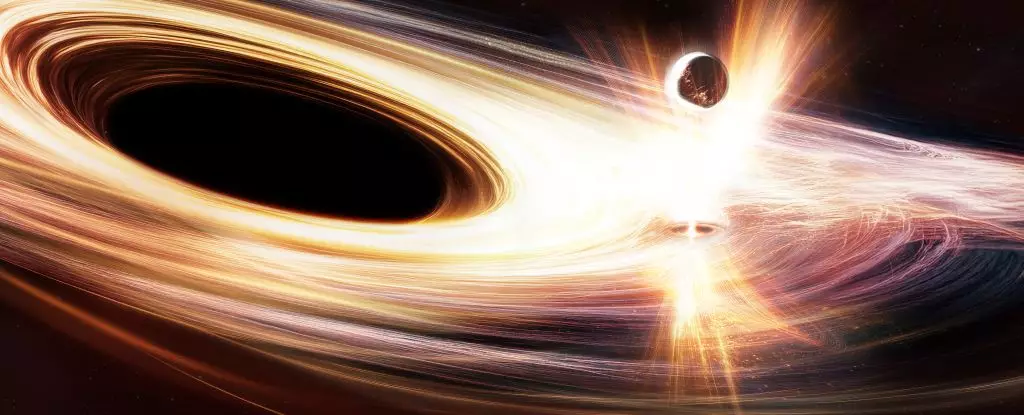In the vast expanse of the universe, a remarkable event has taken place—one that challenges existing paradigms and intrigues the brightest minds in astrophysics. At the heart of the spiraling galaxy SDSS1335+0728, a supermassive black hole known affectionately as Ansky has recently reactivated after a prolonged period of dormancy, captivating researchers since 2019. As astronomers observe this cosmic giant erupting with unprecedented brilliance, they find themselves grappling with questions that defy straightforward answers. What makes Ansky’s behavior so distinct, and what implications does it hold for our understanding of black hole dynamics and galactic evolution?
Defying Conventional Wisdom: Ansky’s Anomalous Activity
Traditionally, supermassive black holes exhibit a somewhat predictable pattern: they alternate between vegetative stillness and episodes of ravenous activity, characterized by their voracious consumption of surrounding material. Ansky’s recent eruptions, however, have taken the scientific community by storm. These outbursts—not only tenfold more luminous than typical quasi-periodic eruptions but also lasting significantly longer—suggest a wealth of energy that has researchers re-evaluating their models. According to astrophysicist Joheen Chakraborty from MIT, each of Ansky’s eruptions releases a mind-boggling hundred times more energy than previously documented, with a cadence stretching up to a remarkable 4.5-day rhythm.
This newfound phenomenon challenges our pre-existing frameworks and invites speculation about the forces at play. Is Ansky a unique case, or does it represent a broader category of behavior among supermassive black holes? This fundamental question drives a significant portion of current research, placing Ansky center stage in the quest for cosmic knowledge.
The Cosmic Vacuum Cleaner Reimagined
Common perception likens black holes to cosmic vacuum cleaners—entities that indiscriminately consume everything in their vicinity. However, the reality is much more complex. Like any massive celestial body, a black hole’s gravitational influence extends only so far, leading to periods of both activity and quiescence. The supermassive black hole residing in our own Milky Way, for example, demonstrates a relatively calm demeanor compared to its fiery counterparts like Ansky. Herein lies the crux of research into supermassive black holes: their behaviors not only affect their immediate environments but also play a pivotal role in the evolution of their host galaxies.
The vital interplay between black hole activity and galactic development reveals a nuanced relationship that transcends mere consumption. Active black holes spur star formation and impact the chemical evolution of their galaxies, while inactive black holes may maintain a subtle form of equilibrium. Understanding this interaction will be crucial as observational evidence mounts, reinforcing the importance of Ansky’s peculiarities in this context.
Real-time Observations: A Historical Milestone
The significance of Ansky cannot be overstated, particularly as it marks the first instance in which scientists have witnessed a supermassive black hole transitioning to an active state in real-time. This pivotal moment has transformed astrophysical research, offering unique insights into black hole behavior previously restricted to theoretical models and simulations. Led by astronomer Lorena Hernández-García from the Millennium Institute of Astrophysics, the research team’s exploration of Ansky allowed them to witness active eruptions unfold over the course of several years—an unprecedented opportunity to comprehend the mechanics behind black hole awakenings.
Yet, while these observations have begun to illuminate critical aspects of black hole behavior, significant gaps remain. What precisely triggers these eruptions? Are they indicative of a commonality among other supermassive black holes, or is Ansky an outlier? Tackling these haunting questions will require extensive data and collaboration among astrophysicists worldwide.
Rethinking the Nature of Gravitational Waves
Further complicating matters, the light emitted from Ansky is strikingly luminous across a range of wavelengths—from infrared to X-rays. Researchers have typically associated similar eruptions with celestial objects, such as stars or smaller black holes, falling victim to the gravitational grasp of supermassive black holes. Ansky, however, seems to rewrite this narrative. The unique nature of its outbursts raises the tantalizing possibility that they are connected to gravitational waves—ripples in spacetime that future missions, like LISA from the European Space Agency, may be poised to capture.
As we continue to unravel the intricate tapestry of Ansky’s cosmic eruptions, the implications for the field of astrophysics expand exponentially. The distinctiveness of Ansky not only reignites our curiosity about black holes but also hints at an evolving understanding of the universe’s most mysterious inhabitants. Ansky stands at the edge of ignorance, beckoning us forward into the vast gulf of discovery that lies ahead.

